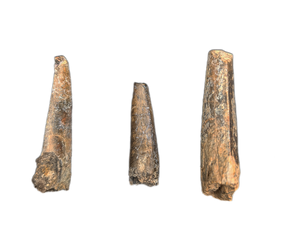The Curious Case of Elrhaz Formation Theropod Teeth
The Elrhaz Formation from Niger is about 125-112 million years old and is rich in Early Cretaceous dinosaur material. Some iconic dinosaurs are from this formation, Suchomimus, Ouranosaurus and Eocacharia, along with the famous giant crocodylomorpha: Sarcosuchus. Material, especially teeth and claws have become available to the market. The problem, how to tell what is what?
The issue: The Jurassic and Cretaceous dinosaur deposits are very near to each other and local fossils diggers often mix the material together. Their color and preservation are quite similar, which makes it hard. The key to this is studying the matrix, color and preservation of two different dinosaur teeth: From the Elrhaz Formation (Cretaceous): Suchomimus, and from the Tiouraren Formation (Jurassic) the spoon shaped sauropod teeth. I was lucky to get a large set of teeth that appear to be all from the Elrhaz Formation. This has allowed me to be able to begin to identify the non Suchomimus theropod teeth.
There appears to be 3 large theropod teeth, not including Suchomimus. Eocarcharia, a rare true Carcharodontosaurinae and a Metricanthosaurid/allosaurid.
Eocacharia is a carcharodontosauridae probably closer to Acrocanthosaurus than Carcharodontosaurus. Their teeth are recurved, compressed (thin) and the mesial serration reaches about ¾ of the way down the tooth. The serration count ranges from 13 - 15 per 5mm on both distal and mesial serrations. The mesial carinae are slightly offset from the distal carinae. These teeth are the second most common non Suchomimus theropod teeth.
The Carcharodontosaurinae are quite rare, as I have seen a couple. These teeth closely resemble Carcharodontosaurus teeth in shape. The tooth I was able to measure has a mesial serration count of 12 per 5 mm.
The Metricanthosaurid/Allosaurid are probably a bit controversial and many are probably labelled as the Jurassic Afrovenator. These teeth have a mesial/distal serration count of around 10-11 serrations per 5mm. The distal serrations only go about ½ way down the tooth. These teeth are not symmetrical, as the mesial carinae is off set like many allosaurus teeth. However the distal serrations ending ½ way indicate it might be metriacanthosaurid. These teeth are not as compressed as Eococharia and Carcharodontosaurinae teeth. These teeth appear to be the most common and can be the largest.
There are also abelisaur teeth from Kryptops, but some of these teeth might be from the noasaurid Afromimus. There are two types of serration count, one where mesial and distal serration are 15-17 per 5 mm, and one where the mesial is 12-13 per 5 mm and the distal is 16-17 per 5 mm. Some of these teeth can get over 1”, which indicates the species is Kryptops, the larger teeth all have the 15-17 per 5 mm serration count on the distal/mesial carinae. Is the 12-13 per 5 mm and the distal is 16-17 per 5 mm Afromimus, maybe, but more research is needed to determine that.
At the Daily Rex we strive to do our best at labelling species. Not everyone will agree, which is OK.


In the pictures the teeth are as follows from left to right: Eocacharia, Metricanthosaurid/Allosaurid, Carcharodontosaurinae


